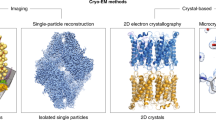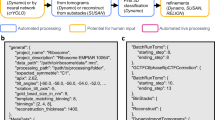Abstract
MicroED uses very small three-dimensional protein crystals and electron diffraction for structure determination. We present an improved data collection protocol for MicroED called 'continuous rotation'. Microcrystals are continuously rotated during data collection, yielding more accurate data. The method enables data processing with the crystallographic software tool MOSFLM, which resulted in improved resolution for the model protein lysozyme. These improvements are paving the way for the broad implementation and application of MicroED in structural biology.
This is a preview of subscription content, access via your institution
Access options
Subscribe to this journal
Receive 12 print issues and online access
$259.00 per year
only $21.58 per issue
Buy this article
- Purchase on Springer Link
- Instant access to full article PDF
Prices may be subject to local taxes which are calculated during checkout



Similar content being viewed by others
References
Barends, T.R. et al. Nature 505, 244–247 (2014).
Chapman, H.N. et al. Nature 470, 73–77 (2011).
Boutet, S. et al. Science 337, 362–364 (2012).
Shi, D., Nannenga, B.L., Iadanza, M.G. & Gonen, T. eLife 2, e01345 (2013).
Iadanza, M.G. & Gonen, T. J. Appl. Crystallogr. 47, 1140–1145 (2014).
Leslie, A.G.W. & Powell, H.R. in Evolving Methods for Macromolecular Crystallography (eds. Read, R.J. & Sussman, J.L.) 41–51 (Springer, 2007).
Battye, T.G., Kontogiannis, L., Johnson, O., Powell, H.R. & Leslie, A.G. Acta Crystallogr. D Biol. Crystallogr. 67, 271–281 (2011).
Dauter, Z. Acta Crystallogr. D Biol. Crystallogr. 55, 1703–1717 (1999).
Evans, P.R. Acta Crystallogr. D Biol. Crystallogr. 67, 282–292 (2011).
Evans, P.R. & Murshudov, G.N. Acta Crystallogr. D Biol. Crystallogr. 69, 1204–1214 (2013).
Winn, M.D. et al. Acta Crystallogr. D Biol. Crystallogr. 67, 235–242 (2011).
McCoy, A.J. et al. J. Appl. Crystallogr. 40, 658–674 (2007).
Sauter, C. et al. Acta Crystallogr. D Biol. Crystallogr. 57, 1119–1126 (2001).
Adams, P.D. et al. Acta Crystallogr. D Biol. Crystallogr. 66, 213–221 (2010).
Gjønnes, J. et al. Acta Crystallogr. A 54, 306–319 (1998).
Oleynikov, P., Hovmöller, S. & Zou, X.D. Ultramicroscopy 107, 523–533 (2007).
Grigorieff, N., Ceska, T.A., Downing, K.H., Baldwin, J.M. & Henderson, R. J. Mol. Biol. 259, 393–421 (1996).
Vincent, R. & Midgley, P.A. Ultramicroscopy 53, 271–282 (1994).
Yonekura, K., Maki-Yonekura, S. & Namba, K. Biophys. J. 82, 2784–2797 (2002).
Gonen, T. Methods Mol. Biol. 955, 153–169 (2013).
Acknowledgements
The authors thank J. Hattne, F.E. Reyes, D. Olbris, H. Tietz and M. Stumpf for helpful discussions. Work in the Gonen lab is supported by the Howard Hughes Medical Institute. A.G.W.L. is supported by the Medical Research Council (U105184325) and Biotechnology and Biological Sciences Research Council (BBSRC; BB/F020384/1) and Collaborative Computational Project Number 4 (CCP4).
Author information
Authors and Affiliations
Contributions
B.L.N. and D.S. contributed to project design, conception, data collection, data analysis, manuscript writing and figure making. A.G.W.L. contributed to data processing and analysis in MOSFLM and manuscript writing. T.G. contributed to project design, conception, data analysis and manuscript writing.
Corresponding author
Ethics declarations
Competing interests
The authors declare no competing financial interests.
Integrated supplementary information
Supplementary Figure 1 Resolution of lysozyme microcrystals collected by continuous rotation.
Lysozyme microcrystals were visualized by cryo-EM prior to data collection and a representative crystal is shown (inset, scale bar represents 1 μm). Well diffracting crystals were typically on the order of 2 μm x 2μm x 0.5 μm in size. The crystal shown is a wedge that measured as 0.5 μm thick at the center and 0.15 μm thick at the edges. A representative diffraction pattern from a lysozyme microcrystal collected under continuous rotation. This individual frame was collected over 4 s at a dose of ∼0.01 e-/Å2/s and a rotation rate of 0.09° s-1. The diffraction pattern shows visible reflections extending to ∼ 2 Å resolution and beyond. The contrast of this image was enhanced in Fiji25 to enable spot visualization for this figure.
Supplementary Figure 2 Radiation damage assessment of continuously exposed microcrystals.
(a) A single crystal was exposed continuously for 120 frames for a final accumulated dose of 12.0 e-/A2 (0.1 e-/A2 per frame). A representative region from diffraction patterns originating from the same crystal in the same orientation is shown as a function of accumulated dose. It can be seen qualitatively that the intensities of the reflections decrease as dose is accumulated, especially at higher resolutions (see arrows in top left panel), and this effect becomes more severe for all reflections at the higher dosages (8.0 e-/A2 and 12.0 e-/A2). (b) In order to more quantitatively investigate the negative effects of radiation damage, intensities in the resolution bins of 2 - 3 Å (2 randomly chosen reflections) as well as 3 - 6 Å (7 randomly chosen reflections) were selected and their normalized intensity as a function of accumulated dose was analyzed. It was found that the higher resolution reflections suffer relatively early (∼2 e-/Å2 of total accumulated dose, blue), whereas the intensities between 3 Å and 6 Å do not decrease drastically until approximately 5 to 6 e-/Å2 of total accumulated dose (black). Error bars represent standard error of the mean.
Supplementary Figure 3 Process flow from raw data to completely processed data set using MOSFLM.
The raw data collected on the TEM is first converted to a file compatible with MOSFLM by an in-house script. MOSFLM then uses automated spot finding to determine the position of the reflections on the images. Following spot finding MOSFLM uses the relative positions of each reflection to determine crystal lattice parameters and the crystals orientation. This then allows the location of each reflection within the data set to be predicted, properly indexed, and integrated. After merging and scaling, process of converting the many raw diffraction patterns into one reflection file is complete.
Supplementary Figure 4 Continuous rotation reduces dynamical scattering.
(a-b) Diffraction patterns near the (001) major planes of lysozyme were used to assess the level of dynamic scattering by looking at the systematic absences along the a* axis for both still diffraction data (a) and continuously rotated diffraction data (b). The data from (a) and (b) come from two different crystals. (c-d) The intensity of reflections along a* was quantified and plotted for the still diffraction and continuously rotated diffraction patterns (the portion of the diffraction patterns indicated by the box inset). The plot from still diffraction (c) clearly show small but significant levels of intensity coming from dynamic scattering for reflections (2n+1,0,0), which are forbidden in P43212 symmetry. The intensities of these forbidden reflections are greatly reduced when continuous rotation is used (d).
Supplementary information
Supplementary Text and Figures
Supplementary Figures 1–4, Supplementary Table 1 and Supplementary Results (PDF 7000 kb)
Effects of radiation damage on reflection intensities.
Representative intensities from a single crystal continuously bombarded by the electron beam were plotted and the decay was tracked as a function of total accumulated dose. The higher resolution data begins to decay first with the lower resolution data withstanding the effects of the radiation for most of the dosage test. The area from the diffraction patterns shown is between approximately 2.5 Å to 7 Å. (MP4 392 kb)
A representative complete 3D electron diffraction data set from a single lysozyme microcrystal collected by continuous rotation.
Diffraction patterns were collected as the stage was continuously rotating at 0.09° s–1. Each pattern represents a 0.36° wedge of data and the entire data set covers about 44° and its comprised of 121 individual frames. (MP4 5323 kb)
MicroED structure of lysozyme determined by continuous rotation and MOSFLM.
2Fobs-Fcalc density around the complete lysozyme model at 2.5 Å resolution (contoured at 1.0σ). The structure originates from the 2-crystal data set. (MP4 2656 kb)
Source data
Rights and permissions
About this article
Cite this article
Nannenga, B., Shi, D., Leslie, A. et al. High-resolution structure determination by continuous-rotation data collection in MicroED. Nat Methods 11, 927–930 (2014). https://doi.org/10.1038/nmeth.3043
Received:
Accepted:
Published:
Issue Date:
DOI: https://doi.org/10.1038/nmeth.3043
This article is cited by
-
Structural resolution of a small organic molecule by serial X-ray free-electron laser and electron crystallography
Nature Chemistry (2023)
-
High-throughput phase elucidation of polycrystalline materials using serial rotation electron diffraction
Nature Chemistry (2023)
-
A robust approach for MicroED sample preparation of lipidic cubic phase embedded membrane protein crystals
Nature Communications (2023)
-
Structure determination of a low-crystallinity covalent organic framework by three-dimensional electron diffraction
Communications Chemistry (2023)
-
Direct structure determination of vemurafenib polymorphism from compact spherulites using 3D electron diffraction
Communications Chemistry (2023)



